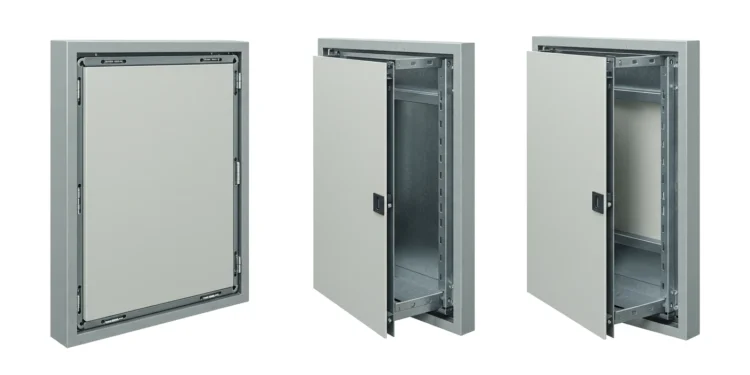Most wiring, junction boxes, and circuit breakers need to be hidden behind walls or ceilings for safety and to maintain a building’s design. But what happens when it’s time for repairs or inspections?
That’s why recessed access doors are necessary.
These access solutions strike the perfect balance: they let builders and electricians reach electrical components safely when needed, while maintaining a polished look on the surface.
What Are Recessed Access Doors?
Recessed access doors are panels built into walls or ceilings to provide access to electrical or mechanical systems. Unlike surface-mounted doors, they’re designed to sit “inside” the wall, flush with the surrounding surface.
These doors feature a special frame that allows them to be installed in a way that their outer edge is level with the drywall, while accommodating finishes like tile, carpet, plaster, and stucco. This design allows the door to virtually disappear once it is closed.
The core purpose of these hidden doors is threefold: concealment, easy accessibility, and protection of delicate electrical components from damage or unauthorized access.
Its common features often include:
- Simple push-latch mechanism (so no visible handle is needed)
- Sturdy concealed hinge for durability
- Recessed receptacle for various material options to suit different environments and fire ratings
Where Aesthetics Meets Accessibility and Safety
The beauty of recessed access doors lies in their ability to solve two major challenges simultaneously: design and practicality. Here’s how they do it:
Aesthetics
One of the biggest advantages of recessed access doors is that they provide varying access solutions for architects and builders looking for form and function.
These doors can be finished to match the surrounding surface, whether with painted drywall, ceramic tile, or plaster.
Safety
Electrical work can be dangerous. Easy access to junction boxes, wiring, and circuit breakers allows for safer inspections, repairs, and modifications.
This reduces the need for inconvenient maneuvers or risky workarounds, lowering the risk of accidents for technicians.
Maintenance Efficiency
Imagine needing to check a faulty connection or add a new circuit. Without a proper access door, you might have to cut into the wall, then repair and repaint the damaged area.
With a recessed access door, opening a hidden panel simplifies the task. This reduces labor time, material waste, and disruption, making routine checks, troubleshooting, and emergency repairs far more efficient.
Code Compliance
Many electrical codes (e.g, the National Electrical Code) require certain clearances and accessibility for electrical components. Recessed access doors help ensure contractors meet these requirements.
Preserving Structural Integrity
Repeatedly cutting into walls for access weakens the structure and damages finishes. A dedicated access door prevents this wear and tear, maintaining the building’s long-term integrity and appearance.
Long-Term Cost Savings
The initial investment in a recessed access door pays off down the line. Reduced labor costs for maintenance, less material needed for repairs, and the extended lifespan of electrical components because of better protection. These all contribute to significant overall savings for the contractor and the building owner.
Locations With Frequent Electrical Maintenance Needs
While recessed access doors can be installed to hide electric wires anywhere, certain locations are more suitable for ongoing maintenance or future modification needs:
- Junction Boxes and Splices: These are perhaps the most common hidden electrical points. When wires are joined or branched, they go into an accessible junction box. An access door ensures these vital connections can be inspected or modified without damaging the wall.
- Conduit Runs and Cable Trays: This includes where electrical conduits or cable trays enter or exit walls or ceilings, or where electricians anticipate future cable additions. A well-placed access door simplifies pulling new wires or inspecting existing runs.
- Low-Voltage Wiring Hubs: Modern buildings have low-voltage systems for data, communication, security, and smart technology. These systems’ central hubs or termination points are often concealed, making access doors essential for troubleshooting or expanding these networks.
- HVAC and Mechanical Controls: Electrical connections for thermostats, zone dampers, and other integrated building systems are often hidden behind walls or ceilings. Access doors in these areas allow technicians to service these controls efficiently.
- Lighting Fixture Access: For recessed lighting, especially fixtures with remote transformers or drivers, an access door can provide easy entry for bulb replacement, wiring checks, or component servicing.
- Behind Appliances: Built-in appliances often have dedicated circuits or shut-off valves behind them. An access door can provide crucial access without pulling out heavy machinery.
- Future-Proofing: Placing recessed access doors in strategic locations allows for easy upgrades or changes to electrical layouts. As technology evolves or building needs shift, it lets building owners save money and avoid certain inconveniences.
Choosing the Right Recessed Access Door for Electrical Setups
Selecting the correct recessed access door is crucial for its effectiveness and longevity. Here are key factors to consider:
Materials
- Galvanized Steel/Cold-Rolled Steel: These are the most common choices because they’re sturdy and durable. They’re suitable for general use.
- Aluminum: Lighter and naturally corrosion-resistant, aluminum doors are ideal for damp environments or areas where weight is a concern.
- Fire-Rated Options: Choose fire-rated access doors to comply with building codes for walls and ceilings that are part of a fire-rated assembly (e.g., 1-hour or 2-hour fire-rated walls).
Size and Placement
The door must be large enough to allow comfortable access for hands, tools, and components. Don’t just pick a size that offers visibility; ensure it provides enough working room for personnel.
It’s also important to place these access panels directly over the components needing access, while keeping future expansion in mind.
Latching Mechanisms:
- Push-Latch/Touch Latch: These are perfect for achieving a seamless look, as the door opens with a simple push, requiring no visible handle.
- Keyed Locks: These are necessary for areas requiring security or restricted access.
- Screwdriver Cam Latch: A basic, secure, and common option that requires a screwdriver to open.
Gasketing and Insulation
In certain applications, such as those requiring airtightness, sound insulation, or energy efficiency, choose doors with proper gasketing or insulation to meet these performance requirements.
Customization
The best recessed access doors can take in various finishes on their panels. This ensures they match the surrounding surface, achieving that desired invisible look.
Wrap Up
While hiding electrical work is necessary for safety, accessibility and design can’t be sacrificed. Recessed access doors offer a holistic solution. They help builders and electricians maintain a sleek, finished look while keeping key systems easy to reach for maintenance and repair.
This enhances safety, reduces long-term costs, and helps builders deliver superior finishes that meet the demands of modern construction.












